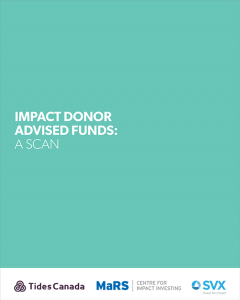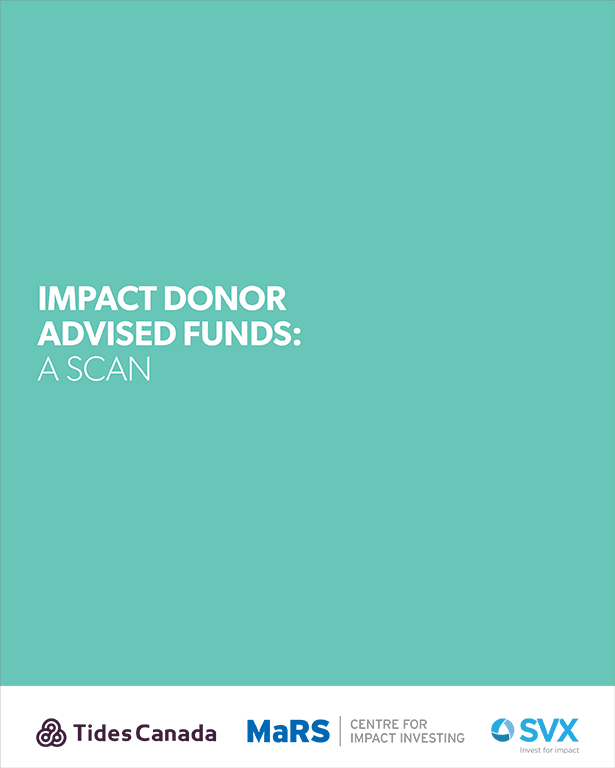By: Marie Ang, Adam Spence, and Todd Jaques
Today, SVX (Social Venture ConneXion) and Tides Canada released a joint paper focused on a novel and emerging social finance instrument in the philanthropic sector—the impact donor advised fund.
 What is a Donor Advised Fund (DAF)?
What is a Donor Advised Fund (DAF)?
Donor advised funds (DAFs) have existed for decades as a tool, housed in a charitable organization, for donors to facilitate targeted grantmaking without the particular requirements of starting and managing a private foundation. A significant and growing pool of philanthropic funds is being dedicated towards DAFs.
How do impact DAFs work?
Generally, most philanthropic assets are relatively agnostic about their impact. Funds are often invested primarily to achieve a return that can support ongoing grantmaking. In the case of an impact DAF, a foundation or DAF manager actively places the donated assets into one or a set of investments that also meets a pre-established impact criteria. As with any other DAF, the proceeds of those investments are still given out in grants. The ultimate benefit of an impact DAF is that all (or a large portion of) the capital involved is directed towards good purpose.
There are a number of leading foundations and organizations that are directing their DAF capital towards impact investments, from investing in affordable housing and community loan funds to investing in local, sustainable food enterprises. This innovative approach to an established tool is gaining momentum and helping foundations and donors mobilize more capital for good.
Insights
We examined eight (8) different organizations to get an understanding of how impact DAFs work in North America. There are a number of interesting insights we gained from our research.
- There is a diversity of strategies for impact investing with DAFs. There is no single approach to impact investing when it comes to DAFs. From customized strategies for every donor, including choice of sector as well as investment product, to a single pool heavily weighted in public securities for all donors, intermediaries, and foundations have different strategies to target different kinds of donors and meet their organisational objectives.
- There is a significant amount of impact investing activity through DAFs. There is clear leadership in impact DAFs from a number of foundations and organizations in Canada and the United States. Over $475 million in DAF assets were dedicated towards impact investments in the case studies for this report alone: a testament to the current uptake of this new approach, and the potential it holds as a key instrument in the future of doing good.
- Although active and successful, impact DAFs do have significant requirements and they do pose challenges. The management of impact DAFs require specialized skills, products, and services. The costs and expertise for appropriate due diligence on impact investments can be prohibitive for foundations who are not typically structured to manage a significant amount of direct investment flow. Specialized intermediaries and firms who can provide solutions including connecting impact capital with pre-screened deal flow can be helpful to DAFs interested in impact investing. Alternatively, an organization will need in-house expertise, time, and resources to create and administer an impact DAF.
Recommendations
We have developed four key recommendations that would build capacity, create new products, and leverage existing infrastructure towards moving more donor-advised fund capital towards impact:
- To support effective and efficient investing, existing DAFs can connect and leverage existing social finance infrastructure like SVX.
- A pooled product for DAFs with a balance of public equities, impact funds, and direct investments to impact ventures could provide a lower risk option for DAF managers.
- A range of sector or place-based strategies can be developed to meet the programmatic needs of DAF managers.
- Advancing capacity building, awareness, and standards for DAFs engaged in impact investing or looking to engage in impact investing is necessary to increase participation in the sector.
You can read more about the impact DAFs we profiled, our insights, and the recommendations in our paper online.
We look forward to hearing your thoughts and feedback on this paper.
